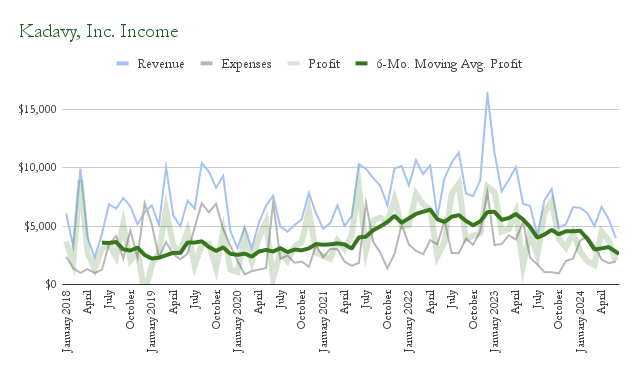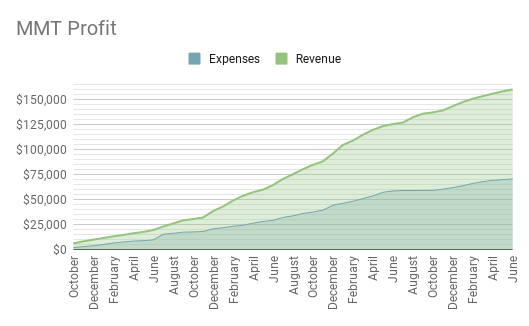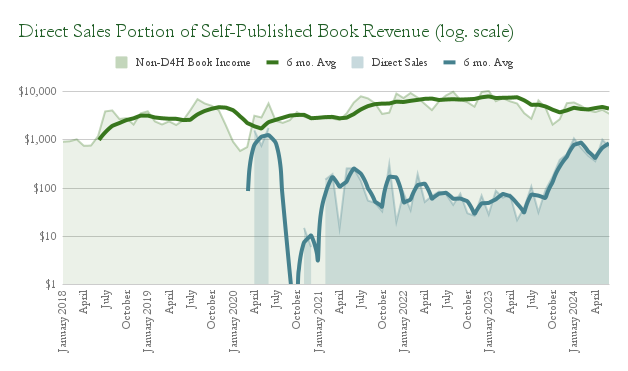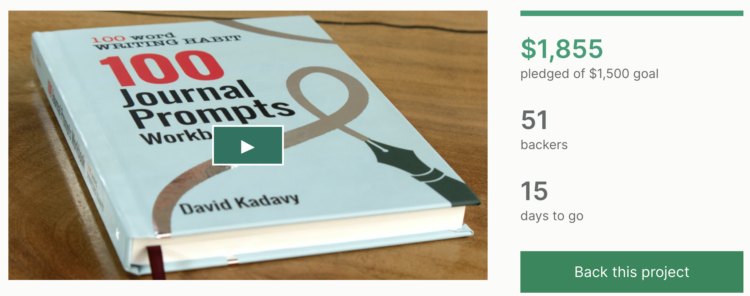Subscribe to blog updates via email »
June 2024 Income Report
To listen to an audio version of this report, join the Patreon »
June’s revenue was $3,972, down from May’s $5,586. Profits were $2,006, down from May’s $3,764.


WANT TO WRITE A BOOK?
Download your FREE copy of How to Write a Book »
(for a limited time)
I barely made it above $2,000 profit this month. Had I not, it would have been the third month this year with under $2,000 profits.
Low profits over past year
Profits are the lowest they’ve been for a twelve-month period since May 2021. For the past twelve months, I’ve made $44,064 in profits. As of May 2021 I had netted considerably less, at $36,959, right before Digital Zettelkasten and the Preview Edition of Mind Management boosted my revenue.
But, I have the highest twelve-month ROI on Advertising spend ever, at 215%. This isn’t a perfect representation of my ability to make profits, as I haven’t perfected accounting for the printing, shipping, and handling expenses of my direct sales. But I’m also spending a good portion of my ad spend just for leads, rather than trying to make sales. I spent $105.86 in ads directed at building my email list.
I could definitely justify investing more in ads, especially when looking at how Mind Management revenue has continued to outpace ad spend.

Why am I not spending more on ads? Because I’m focused on releasing more books. I do sometimes toy with increasing my budgets on my Amazon Ads, but don’t recall those budget increases paying off. Maybe I should give it a second look.
Direct sales growing, but accounting imperfect
The return on my ad spend is distorted by the volume of my direct sales. Last month, my direct sales accounted for 24% of my self-published book revenue, this month they accounted for 20%, and over the past six months they’ve accounted for 16%. This share has exceeded expectations, as at the beginning of the year I wrote that I was 60% confident I could grow the six-month average share to 10%.

If I better accounted for my direct sales expenses, I’d have a clearer picture of what was going on. As I demonstrated in a recent Patreon-only screencast, I keep a direct-sales spreadsheet in which I on a monthly basis tally up my net revenues from my Shopify store, and subtract estimated printing expenses per-unit sold.
This month, I’ve also estimated my handling expenses by simply multiplying the number of orders by $4 (despite that orders with multiple units cost $1 more per unit), and made similar rough calculations to estimate that I made a small amount of profit on shipping charges.
My direct-sales revenues this month were $706, my gross margins were $650, and my profits after shipping and handling were $597. An anomaly this month was that $342 of direct-sales revenue came from the Preview Edition of How to Sell a Book. So my direct sales profits beyond that were about $255.
Most of those direct sales were driven by Meta Ads, on which I spent $306, so it appears I’m losing money on direct sales. But only $200 of that spend was dedicated toward generating sales, so again I’m making money. But those ads are mostly driving sales for 100 Word Writing Habit and How to Write a Book, for which my collective estimated gross margins are only $208. But those orders account for about all my shipping and handling costs of $54.
So I guess I lost about $46 selling books direct through Meta Ads this month. Seems like I should stop doing that, but I’m holding onto hope that I can increase my Average Order Value with the introduction of a 100 Journal Prompts Workbook and the habit wristband, and maybe reduce my handling costs. I also see this money “lost” as acquisition of far more-qualified leads than the ones I’m paying about 50¢ for by advertising lead magnets. So these losses will hopefully be made up for slightly through Customer Lifetime Value. In any case, I’m learning about running Meta Ads, running a Shopify store, fulfilling through a warehouse.
I hope my revenue and profits will be boosted soon by a combination of How to Sell a Book, and the 100 Journal Prompts Workbook.
100 Journal Prompts Workbook Kickstarter
The Kickstarter campaign for the 100 Journal Prompts Workbook is now well underway, with only fifteen days to go. As I write this, the campaign has reached its goal, and has now raised $1,855 of the $1,500 goal.
I’m glad the campaign has reached its goal and that I’ll be making this special premiere edition of the workbook, but I’m disappointed in the response to the campaign thus far. Last month I said I was 90% sure the campaign would reach its $1,500 goal, but I probably would have predicted that it would reach the goal much faster than it did. The goal wasn’t reached until about halfway through the campaign.
Putting together this workbook and campaign was enough work to cause me to question my judgement in attempting it. So I’ll walk myself through my thought process. The reasons for and causes of putting together this journal were:
- I noticed writing prompts performing really well as a lead magnet
- This caused me to try writing prompts, and I discovered they were really useful to get oneself writing
- 100 Word Writing Habit was the one book on my Shopify store that seemed to have a hope of making a profit on Meta Ad spend
- I wanted a companion to the 100 Word Writing Habit book to increase my Average Order Value when advertising on Meta, to make a profit
- A quote essentially about journaling from the 100 Word Writing Habit book was performing really well in Meta Ads
- I’ve benefitted a lot from journaling and think it’s a great avenue through which to build a writing habit
- I think the world would be better if more people journaled
- I wanted to try a Kickstarter campaign to see what it was like and consider doing one for my next major book
- I wanted to try making a premium edition of something using BookVault’s new Bespoke service (or offset printing, if volume permitted)
- I thought it would be fun
As I review all these reasons and causes, I feel better about having pursued this workbook. If nothing else, it’s a way to learn about a lot of things: Can I spend Meta Ads profitably? Can I increase my AOV and reduce my per-unit handling costs by creating companion products that belong together? What is it like to run a Kickstarter campaign in the ‘20s? How do people respond to premium touches such as silver foil and placeholder ribbons? What methods can I use to financially model campaigns like this to ensure healthy profit margins? How do I plan, shoot, and produce a decent video on my own?
Could I have had more success doing something else?
But, just as one needs to be wary of how they justify their failures, I’m starting to become wary of how I justify my successes. It’s easy to look at the outcome of a project and come up with reasons you believe it was successful, but it’s much harder to think of the thousand other things you could have done with the same resources to have much more success.
One of the big mysteries about this project and the 100 Word Writing Habit book is about audience, and who I want to serve. The book itself is one of my least successful, yet on Meta Ads it’s been the easiest book to sell. How much of that difference is a function of the type of book idea in the type of context, and how much of that is about who is seeing it?
I think of my audience as creative, entrepreneurial, and non-conformist. But the orders I’m seeing come through on Meta Ads for the 100 Word Writing Habit book seem to come from people who are everyday people in rural America. Should I ignore that market because they’re “not my audience,” or should I lean in because it for me is an untapped market with potential, and people who would really benefit from my work?
How deep is that well? What wells am I not drilling because I’m getting excited about a few drops from this well? I can talk myself out of asking those questions by thinking of what I’m learning while exploring this well, but goddammit I’m getting sick of working so hard for so little money.
And as I write this I’m reminding myself there’s still time for this Kickstarter campaign to earn more money, and once this premiere edition is out, I can release a paperback version and start selling it bundled with the book and wristband. But then I remind myself it may all be a distraction. But then I remind myself I’m learning skills I can use for some future, bigger, more successful project.
I guess the point is I’m doubting my decisions lately. That can be exciting because it causes you to make big changes that sometimes work.
How to Sell a Book Preview Edition almost finished!
I’ve closed the How to Sell a Book Preview Edition sales. I’ve now delivered over 50,000 words to customers, have written 60,000 words, and maybe there’s another 10,000 to go before I finish? The word count just keeps climbing. I think this may be my longest book ever.
I’m wondering what to do with this book once the First Edition is ready. I initially wanted to just write a quick short read and put it out there, but the book is quite long. And I believe the information in it is valuable. Perhaps too valuable to put in a $9.99 Kindle book.
I definitely want to try a “tiered release” with this book. I’ve taken Preview Edition customers, but would like to next sell only through my Shopify store, before releasing it to Amazon and other retailers. Besides the learning experience, that would maximize my profit margin from my loyal readers, without giving Amazon money they haven’t earned.
The cost of the paperback will probably be $30 or $40, which are common price points for a “trade” book. The contents are designed to help the reader more than make up for the price of the book. The ebook should be more than $9.99, at which Amazon forces authors to price their Kindle books.
Is this one book multiple books?
This has me wondering whether I might want to break it up into multiple books. I haven’t reflected closely enough at the contents of the book to consider how well it might logically split up into two or more books. It feels weird to make it “Book 1” and “Book 2”, each at $9.99, for example, just to eschew Amazon’s pricing policies. But I actually might do that.
There’s also so much content I’ve started to wonder if I should make it a Substack. I could break it up into articles and release it bit by bit, with some sections for paid Substack subscribers. I’ve been curious about Substack, but have felt it was more for practical content worth charging for.
Then again, I’m thinking about this book way more than I ever wanted to. Instead of trying to squeeze every bit of possible potential out of it, maybe I should get it out there and move on. Use my energy on the thousand other things that might have a higher ROI, whether in money, or fun.
How to Write a Book Spanish audiobook
The one foreign translation I’ve produced myself, the Spanish version of How to Write a Book, now has an audiobook version!
Before you get too excited, no it’s not me speaking Spanish with a heavy gringo accent.
Amazon now has AI-narrated audiobooks, with a neat program for changing the speed and inflection of the reading. I had already used it once to create an audiobook version of one of the short stories I’ve released under my secret fiction pen name, but this is my first time using it for one of my own books.
I wouldn’t use AI narration for one of my major books, but this might be a good way to squeeze a little more revenue out of a translation experiment that’s been a financial failure. I paid, $250 to translate it in 2018, and have since netted only $700 in royalties.
New on Patreon: My carry-on gear for travel
My latest addition only for Patreon supporters is a video describing my carry-on gear for travel. I made many trips in the first half of the year, and in the process optimized what gear I bring onto flights as carry on, and how. One surprising find was that, despite having a budget of $300 for a new backpack, I couldn’t find one better than what I bought for $30.
I’ve been trying to add at least one new piece of bonus content per month over the past several months, just for Patreon supporters. Most have been screencasts and this latest is a video. Some other recent additions:
- How I compile book-sales reports as a “wide” self-published author
- How I use Todoist for GTD and Mind Management
- Evaluating foreign-rights opportunities as a self-published author
- Quarantining and Warming Up New Email Subscribers from Facebook Lead Ads
- A tour of my Shopify store & Meta ads
Join the Patreon to get instant access to all these, plus audio versions of these reports.
Thank you for interviewing me
Thank you to Jim Fitzpatrick for interviewing me on CBT News.
Income
Book Sales
| Mind Management, Not Time Management Kindle | $360 |
| Mind Management, Not Time Management Paperback (Amazon) | $901 |
| Mind Management, Not Time Management (non-Amazon) | $238 |
| Mind Management, Not Time Management Audiobook | $444 |
| 100-Word Writing Habit | $237 |
| Digital Zettelkasten Kindle | $369 |
| Digital Zettelkasten Wide (non-Kindle) | $277 |
| Digital Zettelkasten Audiobook | $37 |
| The Heart to Start Kindle | $116 |
| The Heart to Start Paperback (Amazon) | $51 |
| The Heart to Start “Wide” (non-Amazon) | $9 |
| The Heart to Start Audiobook | $13 |
| How to Sell a Book (Preview Edition) | $342 |
| How to Write a Book Kindle | $16 |
| How to Write a Book Paperback | $7 |
| How to Write a Book “Wide” (non-Amazon) | $45 |
| How to Write a Book Audiobook | $11 |
| How to Write a Book Spanish (all) | $19 |
| Total Book Sales | $3,492 |
Digital Products
| Summer of Design | $9 |
| Total Digital Products | $9 |
Affiliates / Advertising
| Active Campaign | $256 |
| Alliance of Independent Authors | $0 |
| Amazon | $63 |
| SendOwl | $5 |
| Total Affiliates | $324 |
Reader Support
| Patreon | $146 |
| Total Reader Support | $146 |
Services
| Clarity | $0 |
| Medium | $0 |
| Total Services | $0 |
| GROSS INCOME | $3,972 |
Expenses
General
| Accounting | $315 |
| Book Printing | $0 |
| Outside Contractors | $0 |
| Quickbooks | $27 |
| Total General | $342 |
Advertising
| Amazon | $956 |
| BookBub | $0 |
| $1 | |
| Meta | $306 |
| Influencer Marketing | $0 |
| Product Samples | $0 |
| Total Advertising | $1,263 |
Hosting
| ActiveCampaign | $135 |
| Bookfunnel | $15 |
| Drafts | $2 |
| Dropbox | $10 |
| Fathom Analtyics | $14 |
| Libsyn | $5 |
| Namecheap | $0 |
| Obsidian Publish | $10 |
| SendOwl | $9 |
| Shopify | $39 |
| Ulysses | $3 |
| WP Engine | $96 |
| X (Twitter) | $8 |
| Zapier | $14 |
| Total Hosting | $360 |
| TOTAL EXPENSES | $1,965 |
| NET PROFIT | $2,006 |





